Abstract
OBJECTIVE--To describe the characteristics of wheeze and its relation with doctor diagnosed asthma in children aged 5 years and under. DESIGN--Questionnaire survey of population based random sample of children registered on Leicestershire Health Authority's child health index for immunisation; questionnaire completed by parents. SUBJECTS--1650 white children born in 1985 to 1989 who were surveyed in 1990. MAIN OUTCOME MEASURES--Age distribution, severity, precipitants, seasonal characteristics, and diurnal variation of wheeze, family history of asthma/atopy, and their association(s) with doctor diagnosed asthma. RESULTS--There were 1422 replies (86.2%). Two hundred and twenty two (15.6%) were reported to have wheezed and of these 121 (8.6%) had formally been diagnosed as having asthma. More than 80% of the former had recurrences of wheeze and 40% (72) had three or more episodes in the preceding 12 months. Age, number of episodes per year, the severity of shortness of breath with attacks, and precipitants other than colds were the major factors determining the probability that a wheezy child will be diagnosed as having asthma. The data also suggest that despite the strong association of symptom based criteria with the label asthma, asthma was not diagnosed by these same severity criteria in one quarter of cases. CONCLUSIONS--Clinical and physiological follow up studies of children identified as asthmatic by the above criteria during the preschool years should validate or refute the predictive value of these measures of wheeze severity.
Full text
PDF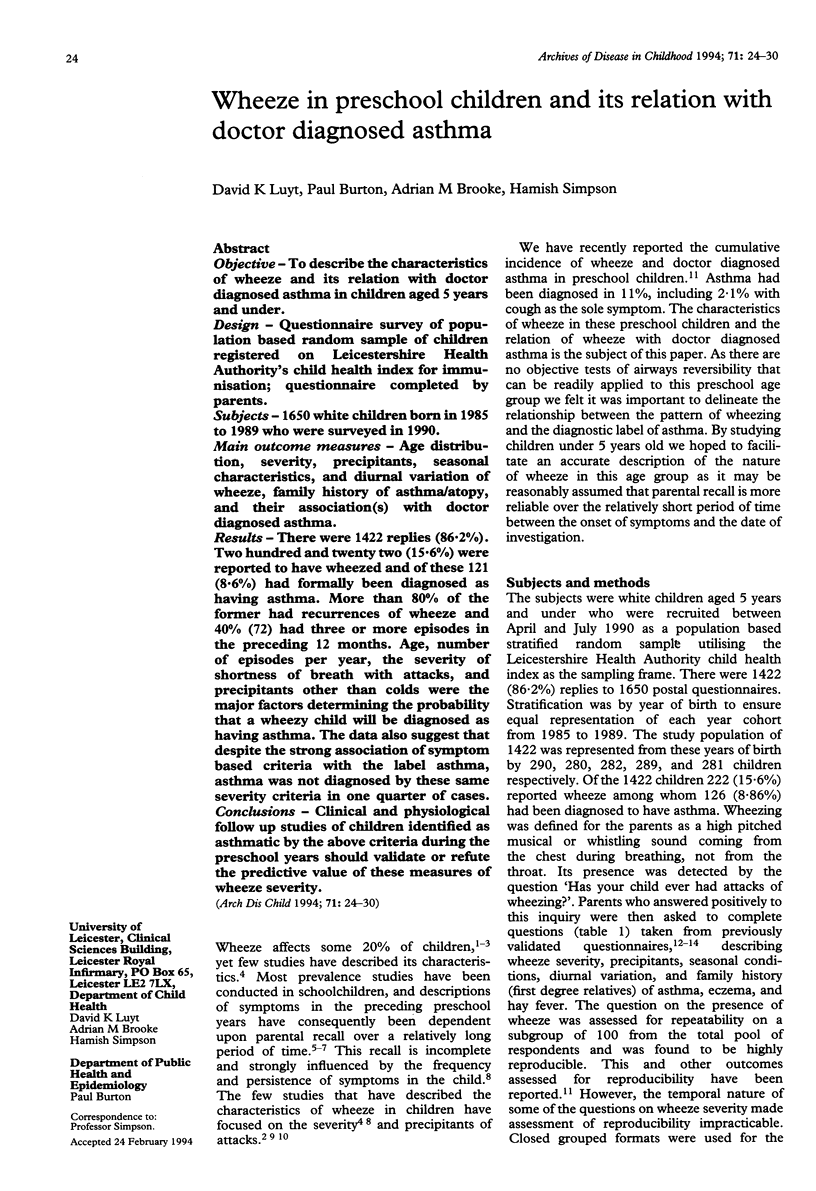
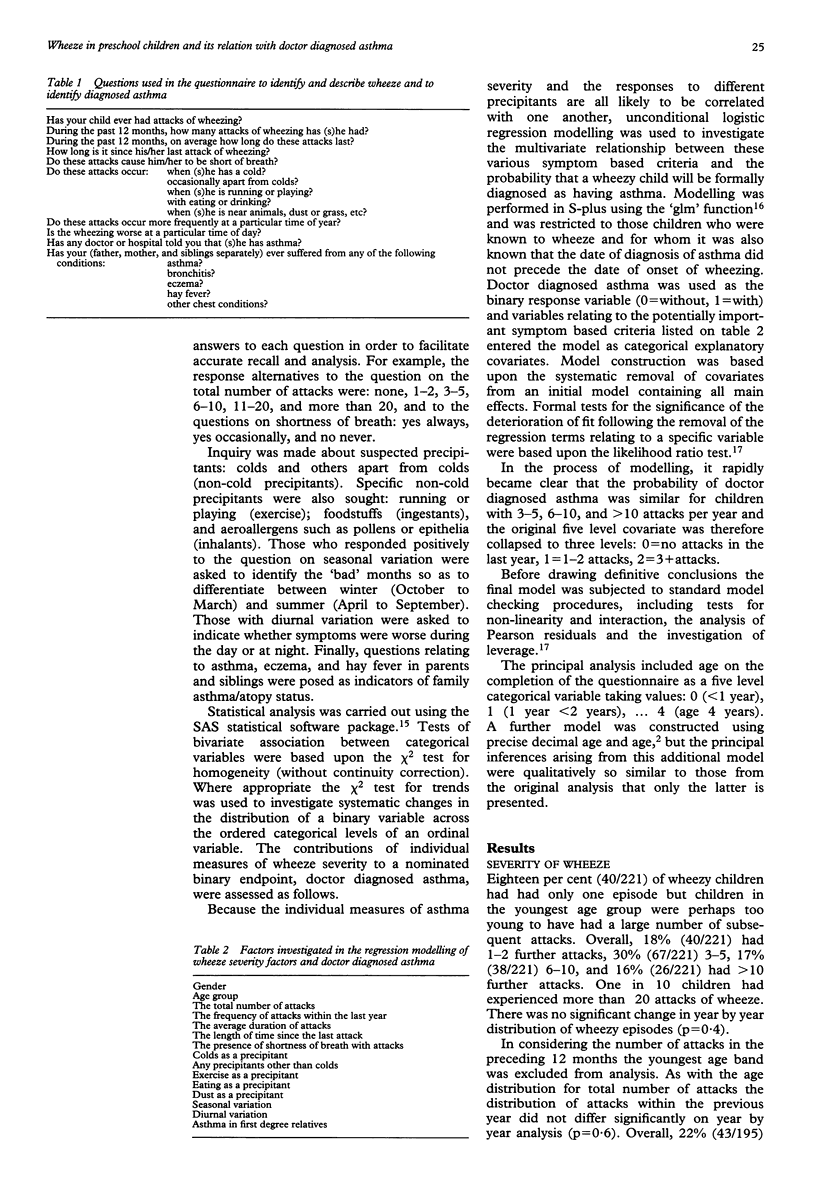
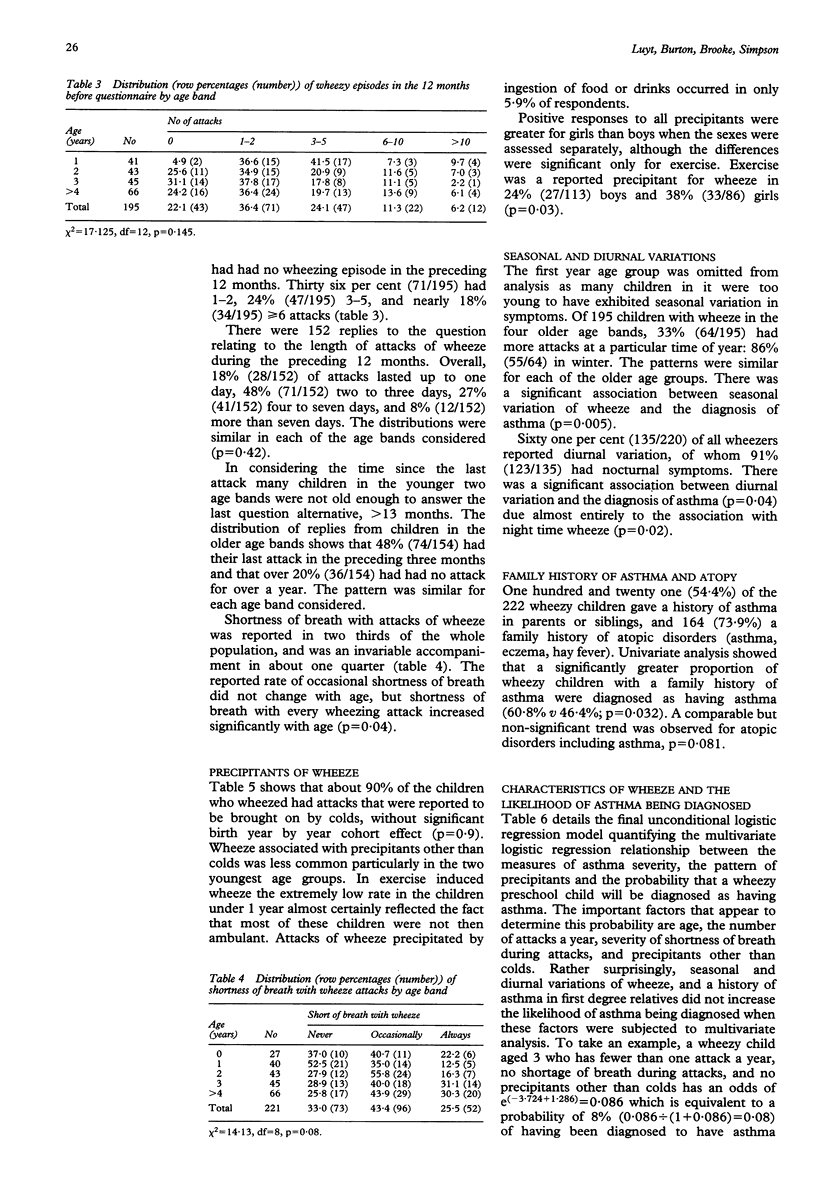
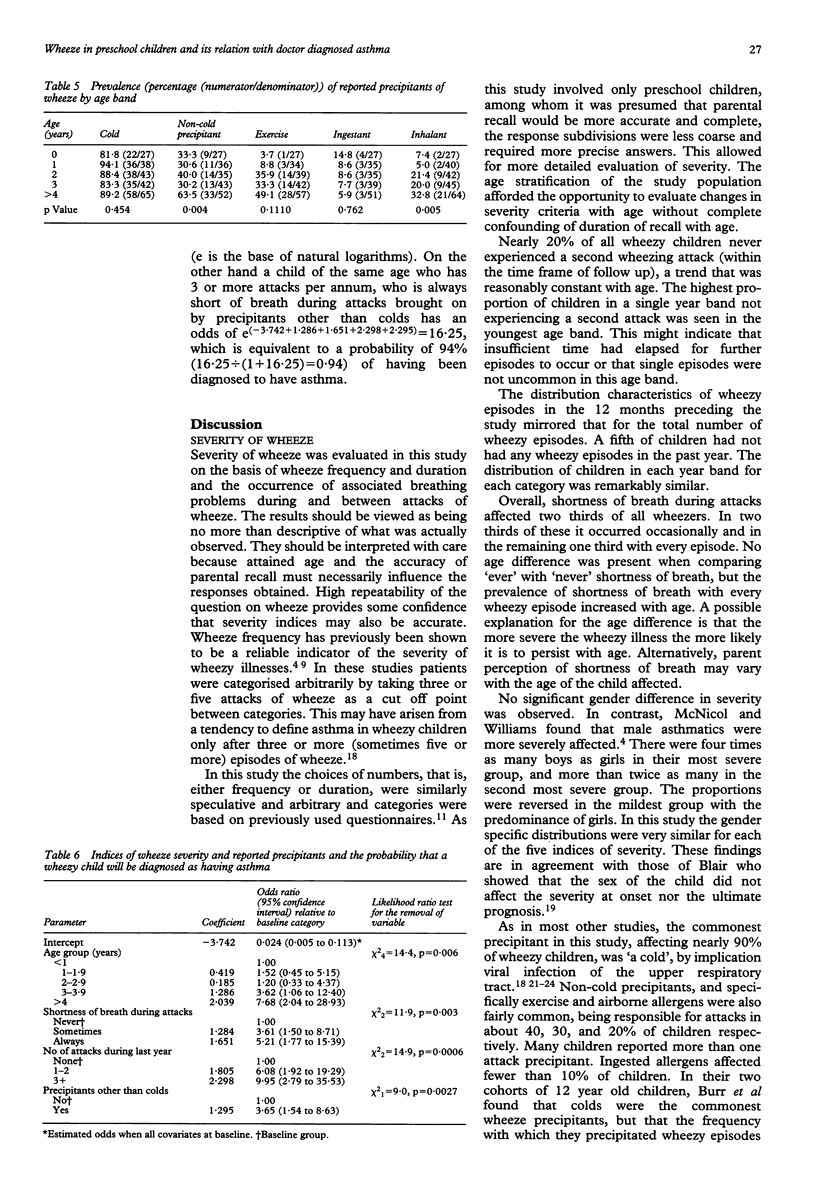
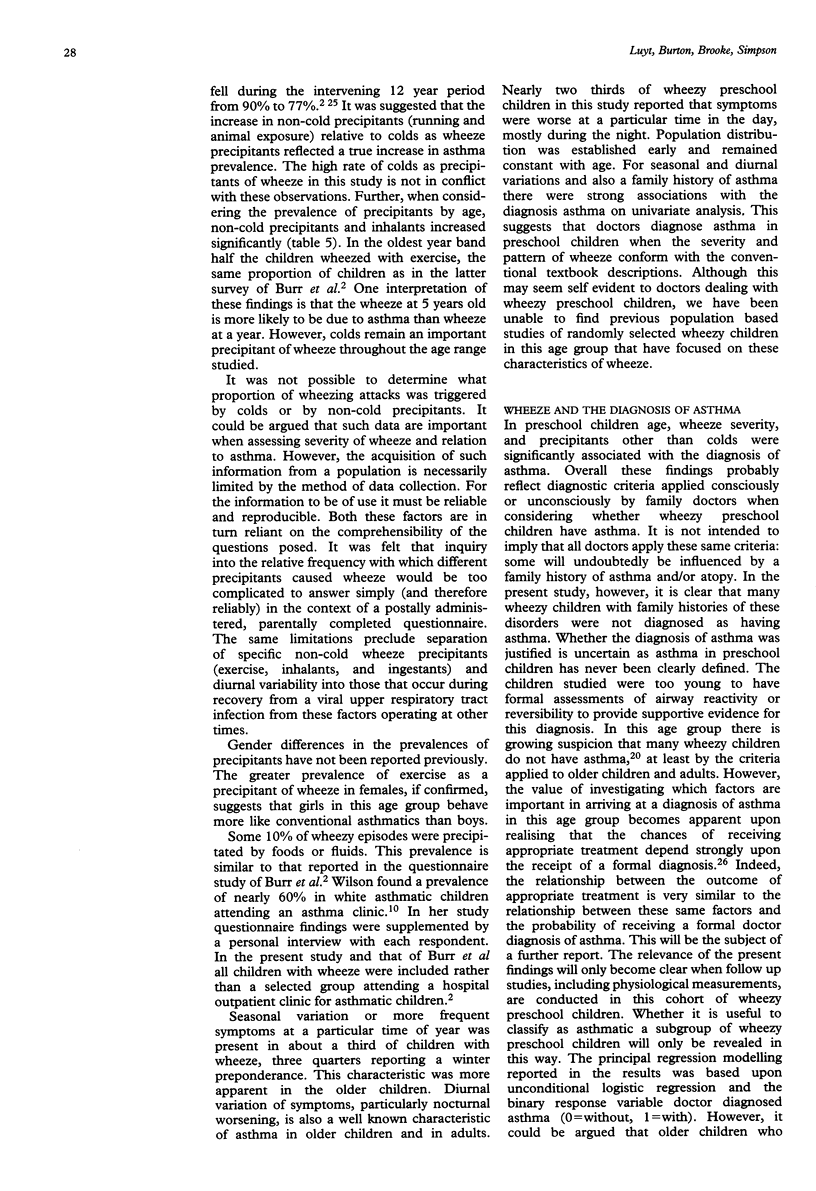
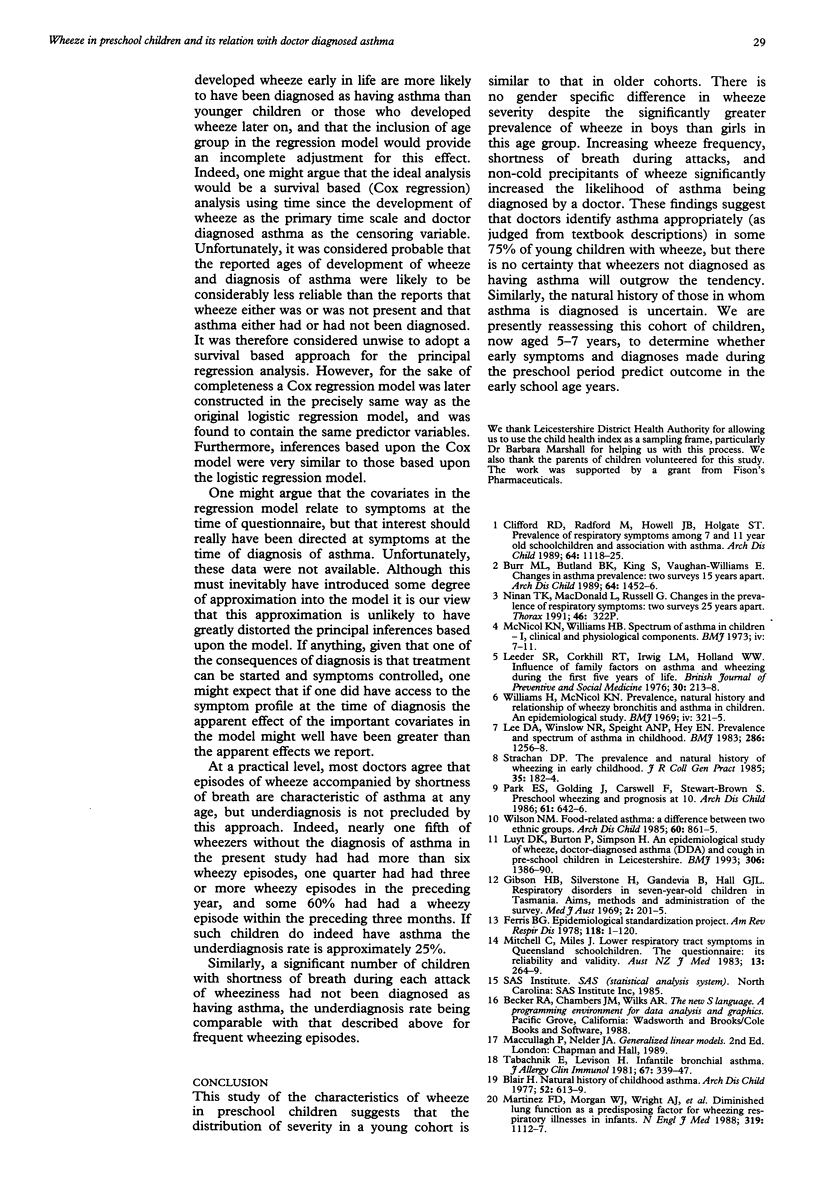
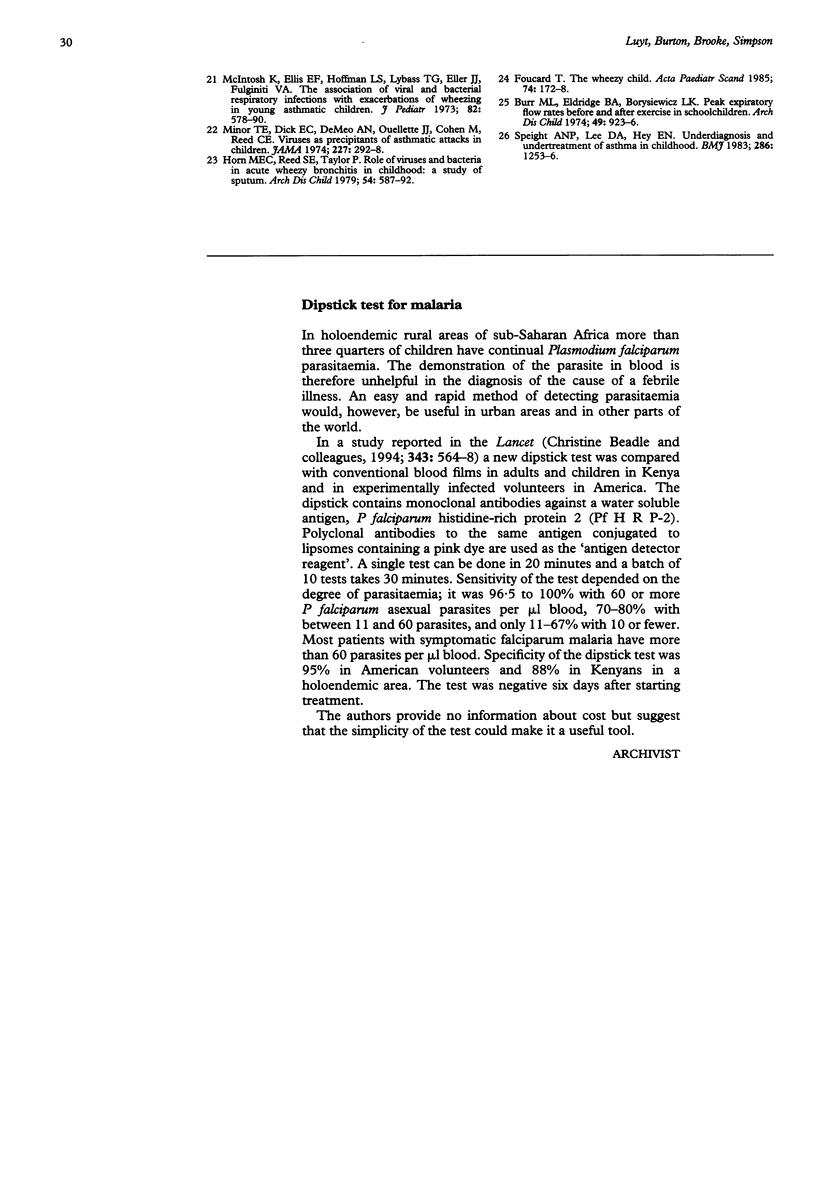
Selected References
These references are in PubMed. This may not be the complete list of references from this article.
- Blair H. Natural history of childhood asthma. 20-year follow-up. Arch Dis Child. 1977 Aug;52(8):613–619. doi: 10.1136/adc.52.8.613. [DOI] [PMC free article] [PubMed] [Google Scholar]
- Burr M. L., Butland B. K., King S., Vaughan-Williams E. Changes in asthma prevalence: two surveys 15 years apart. Arch Dis Child. 1989 Oct;64(10):1452–1456. doi: 10.1136/adc.64.10.1452. [DOI] [PMC free article] [PubMed] [Google Scholar]
- Burr M. L., Eldridge B. A., Borysiewicz L. K. Peak expiratory flow rates before and after exercise in schoolchildren. Arch Dis Child. 1974 Dec;49(12):923–926. doi: 10.1136/adc.49.12.923. [DOI] [PMC free article] [PubMed] [Google Scholar]
- Clifford R. D., Radford M., Howell J. B., Holgate S. T. Prevalence of respiratory symptoms among 7 and 11 year old schoolchildren and association with asthma. Arch Dis Child. 1989 Aug;64(8):1118–1125. doi: 10.1136/adc.64.8.1118. [DOI] [PMC free article] [PubMed] [Google Scholar]
- Ferris B. G. Epidemiology Standardization Project (American Thoracic Society). Am Rev Respir Dis. 1978 Dec;118(6 Pt 2):1–120. [PubMed] [Google Scholar]
- Foucard T. The wheezy child. Acta Paediatr Scand. 1985 Mar;74(2):172–178. doi: 10.1111/j.1651-2227.1985.tb10945.x. [DOI] [PubMed] [Google Scholar]
- Gibson H. B., Silverstone H., Gandevia B., Hall G. J. Respiratory disorders in seven-year-old children in Tasmania. Aims, methods and administration of the survey. Med J Aust. 1969 Jul 26;2(4):201–205. [PubMed] [Google Scholar]
- Horn M. E., Reed S. E., Taylor P. Role of viruses and bacteria in acute wheezy bronchitis in childhood: a study of sputum. Arch Dis Child. 1979 Aug;54(8):587–592. doi: 10.1136/adc.54.8.587. [DOI] [PMC free article] [PubMed] [Google Scholar]
- Lee D. A., Winslow N. R., Speight A. N., Hey E. N. Prevalence and spectrum of asthma in childhood. Br Med J (Clin Res Ed) 1983 Apr 16;286(6373):1256–1258. doi: 10.1136/bmj.286.6373.1256. [DOI] [PMC free article] [PubMed] [Google Scholar]
- Leeder S. R., Corkhill R. T., Irwig L. M., Holland W. W. Influence of family factors on asthma and wheezing during the first five years of life. Br J Prev Soc Med. 1976 Dec;30(4):213–218. doi: 10.1136/jech.30.4.213. [DOI] [PMC free article] [PubMed] [Google Scholar]
- Luyt D. K., Burton P. R., Simpson H. Epidemiological study of wheeze, doctor diagnosed asthma, and cough in preschool children in Leicestershire. BMJ. 1993 May 22;306(6889):1386–1390. doi: 10.1136/bmj.306.6889.1386. [DOI] [PMC free article] [PubMed] [Google Scholar]
- Martinez F. D., Morgan W. J., Wright A. L., Holberg C. J., Taussig L. M. Diminished lung function as a predisposing factor for wheezing respiratory illness in infants. N Engl J Med. 1988 Oct 27;319(17):1112–1117. doi: 10.1056/NEJM198810273191702. [DOI] [PubMed] [Google Scholar]
- McIntosh K., Ellis E. F., Hoffman L. S., Lybass T. G., Eller J. J., Fulginiti V. A. The association of viral and bacterial respiratory infections with exacerbations of wheezing in young asthmatic children. J Pediatr. 1973 Apr;82(4):578–590. doi: 10.1016/S0022-3476(73)80582-7. [DOI] [PMC free article] [PubMed] [Google Scholar]
- Mcnicol K. N., Macnicol K. N., Williams H. B. Spectrum of asthma in children. I. Clinical and physiological components. Br Med J. 1973 Oct 6;4(5883):7–11. doi: 10.1136/bmj.4.5883.7. [DOI] [PMC free article] [PubMed] [Google Scholar]
- Minor T. E., Dick E. C., DeMeo A. N., Ouellette J. J., Cohen M., Reed C. E. Viruses as precipitants of asthmatic attacks in children. JAMA. 1974 Jan 21;227(3):292–298. [PubMed] [Google Scholar]
- Mitchell C., Miles J. Lower respiratory tract symptoms in Queensland schoolchildren. The questionnaire: its reliability and validity. Aust N Z J Med. 1983 Jun;13(3):264–269. doi: 10.1111/j.1445-5994.1983.tb04655.x. [DOI] [PubMed] [Google Scholar]
- Park E. S., Golding J., Carswell F., Stewart-Brown S. Preschool wheezing and prognosis at 10. Arch Dis Child. 1986 Jul;61(7):642–646. doi: 10.1136/adc.61.7.642. [DOI] [PMC free article] [PubMed] [Google Scholar]
- Speight A. N., Lee D. A., Hey E. N. Underdiagnosis and undertreatment of asthma in childhood. Br Med J (Clin Res Ed) 1983 Apr 16;286(6373):1253–1256. doi: 10.1136/bmj.286.6373.1253. [DOI] [PMC free article] [PubMed] [Google Scholar]
- Strachan D. P. The prevalence and natural history of wheezing in early childhood. J R Coll Gen Pract. 1985 Apr;35(273):182–184. [PMC free article] [PubMed] [Google Scholar]
- Williams H., McNicol K. N. Prevalence, natural history, and relationship of wheezy bronchitis and asthma in children. An epidemiological study. Br Med J. 1969 Nov 8;4(5679):321–325. doi: 10.1136/bmj.4.5679.321. [DOI] [PMC free article] [PubMed] [Google Scholar]
- Wilson N. M. Food related asthma: a difference between two ethnic groups. Arch Dis Child. 1985 Sep;60(9):861–865. doi: 10.1136/adc.60.9.861. [DOI] [PMC free article] [PubMed] [Google Scholar]


